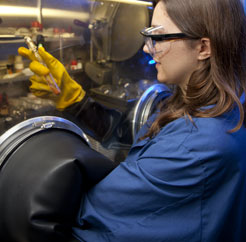
Chemistry professor Paul Fischer draws nearly half a million dollars in research and equipment grants to Mac this year.
In this chemistry lab, one observes no mysterious mixtures bubbling musty gases into the air, no green sparks flying between exposed wires, and no open flasks. In fact, chemistry professor Paul Fischer can never touch the substances he works with. Because they are sensitive to air and moisture, the substances he investigates are boiled, distilled, synthesized, filtered, and crystallized all within what appears to be a mile of custom-blown glassware. Fischer designed the complex glass maze, arranged for a glassblower to create it, and then spent a month assembling the system.

When the solid substances must be manipulated, it’s done within a glovebox, one of those clear, sealed boxes with rubbery black arms projected into the room by the pressure within. By slipping his arms into the long black gloves, the chemist is able to reach into the box to handle materials and perform the necessary task.
“This is organometallic research; we’re creating new metal complexes with attached molecules,” explains Fischer. “We want to know how metals adjust reactivity.” In industry, these insights result in improving catalysts used to make polymers. In pharmacology, metal-based reactivity has implications in selectively making and breaking bonds to assemble complex molecular structures.”
This specialized area of chemistry fascinates the two student researchers who worked with Fischer this summer: Michelle Neary, ’11 and Kevin Sullivan, ’12. When Neary heard about his work, she immediately emailed Fischer, asking to conduct this research, research she will soon present in her senior honors paper. ( Neary will attend Columbia University in the fall for her PhD in chemistry.)
Because of the reactivity with air and moisture, this research requires highly advanced techniques, the kind not usually employed outside of industry or graduate school. Sullivan, jazzed by the intricate work, shrugs off the challenge, “It’s assumed in chemistry class that you’re motivated to learn some things yourself—but assistance is always there if you need it.”
Neary and Sullivan also are co-authors on Fischer’s most recent publication in the prestigious chemistry journal Organometallics.
Fischer is the Principal Investigator (PI) of a $187,000 National Science Foundation Research at Undergraduate Institutions grant that paid for summer research assistance from Neary and Sullivan, and will pay for two students each summer for a total of three years. The other NSF grant for which Fischer is the PI, $298,600 for three years, will purchase a state-of-the-art nuclear magnetic resonance (NMR) instrument that will be used by faculty and students from both on and off campus to study molecular structure.
“The NMR spectrometer will permit significant infusion of modern NMR technology into chemistry, biology and biochemistry curricula as faculty with a variety of scholarly interests serve as co-PIs on this effort (Rebecca Hoye (chemistry), Kathryn Splan (biochemistry), Ronald Brisbois (chemistry), and Paul Overvoorde (biology)). The new spectrometer will also enhance student research experiences in these areas.” says Fischer. “We’re preparing the next generation of scientists to engage whatever contemporary scientific challenges they face.”
After Mac
Michelle Neary is pursuing a PhD in Chemistry at Columbia University
October 5 2010
Back to top




